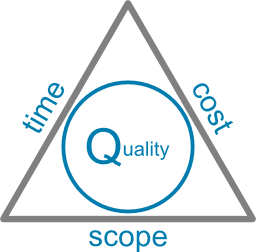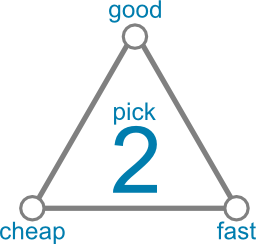 The project management triangle is an illustration of how a project’s constraints correlate.
The project management triangle is an illustration of how a project’s constraints correlate.
It is a useful tool to help stakeholders and customers understand that they can’t get everything (“pick any two”). It can also be the starting-point for discussions about a project’s relative priorities.
The project management triangle is usually shown as in the figure below. The sides show three constraints in project management: time, cost and scope. Quality is put in the middle to illustrate how it relates to the three constraints.

Variants
The project management triangle comes in many shapes and forms. Not even necessarily as a triangle. The labels also differ slightly. Scope may be replaced by features or functionality. Cost by resources or budget. Time by timeline or schedule. The meaning is the same, though.
Sometimes the labels are put on the corners instead of the sides, as in the figure below.

The project triangle can also be shown as a trilemma. The labels are then replaced by fast, good and cheap. It is in this context you say “pick any two”. The remaining constraint depends on the other two – and cannot be controlled. For example, you can build something fast and cheap, but it will probably not be very good.

There are also other versions, for example the project diamond and PMIs point star (two inverted triangles where the second one depicts risk, quality and resources).
While these and other “evolved” versions of the project management triangle may better depict the real complexity of projects, they lose some of the simplistic beauty of the traditional triangle.
Possible Use
As the project triangle shows a simplified picture of a project, it works best as the basis for discussions and to illustrate a point.
As an example: in a previous post called Fixed Price Contracts - A False Sense of Security? I write about how fixed prices “lock” all sides of the triangle and significantly increase the risk of project failure. In other words, in the context of a fixed price contract, the project triangle shows how quality is the only factor workable by the contractor.
Scrum and the Project Management Triangle
It might seem like Scrum disregard the basic idea of the project management triangle. Sprints have locked time, cost and functionality. The time of a sprint is always the same. The team should not change. The team has also committed to finishing a set number of user stories, or features.
The truth is that while a sprint seemingly violates the prerequisites of the project triangle, quality is never supposed to be jeopardized.
Using the concept of velocity, Scrum teams adapt the scope iteratively after each completed sprint. It is ok not to finish all the user stories in a sprint. Sprints even have built-in quality assurance in the form of the definition of done.
As the definition of done is continuously worked on and improved, the Scrum team also assures quality of delivered code improves.
Dig Deeper - Useful Web Resources
Project Management Triangle
Wikipedia’s article about the project management triangle.
Every Project Plan is a Triangle
Article written by Microsoft about the project triangle. Writes about “stuck sides” and how to optimize for the different sides of the triangle.


The core principles of the “triangle offence” revolve around creating space from increased ball and player movement, thus pulling the defensive team around the court. The system only works if any attacking player is willing to take an open shot, when the opportunity arises.u can visit http://www.scrumstudy.com for more info
ReplyDeleteGreat Article
DeleteProject Centers in Chennai
JavaScript Training in Chennai
JavaScript Training in Chennai
Hi there,
ReplyDeleteI have chkd this website
http://www.scrumstudy.com.
wonderfull website.i got myself enrolled here.
their management are intended to be anything but difficult to utilize, straight-forward, and snappy.online project management web app Each individual from the group profits by this, as there is less time squandered with programming that may not work viably with regards to arranging a task.
ReplyDelete